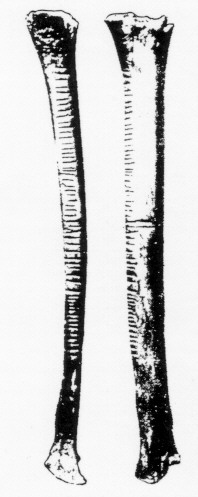To count, our ancestors used such material representations of quantities as tally cuts in bone or ivory or stone; clay tokens; tally sticks; knots in cords, pebbles in bags; marks on walls; wooden beads on a wire; etc.
Tallying is apparently the earliest form of writing.  A
wolf bone found in Europe, dating from the period of 30,000-25,000 B. C., shows fifty-five cuts in groups of five. Certainly, tallies provided the earliest form of bookkeeping
A
wolf bone found in Europe, dating from the period of 30,000-25,000 B. C., shows fifty-five cuts in groups of five. Certainly, tallies provided the earliest form of bookkeeping
Do you know why some financial investments are called "stocks"? A stock is a stout stick. Thus, a stockade is a fort or prison bordered by tall sticks, driven into the ground, edged together, to keep domestic animals in, others out. Cattle or other animals fenced in by sticks constituted farm stock. <
When a client gave money to a broker to invest, the broker broke a stick in two pieces, keeping part for himself, the other part given to the investor. When the investor returned to claim capital or interest, he identified himself by fitting his broken stock to that of the investor. Legend has it that "Wall Street" began under a chestnut tree on lower Manhattan Island. The tree provided a plenitude of sticks to represent stocks. > This was one form of a tally stick to represent a count of something. We learn in school to tally countables.
Once only a small elite could read, write, and calculate. Illiterate clerks used notched tally sticks to inventory coins or bars of gold or silver, etc. Thus one notch touched represented a coin counted. When all notches of a stick had been assigned, the stick was laid aside, and a new tally stick accounted for more coins. This was once the procedure in The Exchequer -- the English treasury, so-called because, originally, officials sat at a table covered with a checkered cloth.
Long before Dickens' time, literate clerks of The Exchequer ceased to use tally sticks. In 1724, treasury officials commanded that tallies no longer be used, but they long remained valid.
Said Dickens, "... it took until 1826 to get these sticks abolished. In 1834 ... there was a considerable accumulation of them. ... [W]hat was to be done with such worn-out worm-eaten, rotten old bits of wood? The sticks were housed in Westminster, and it would naturally occur to any intelligent person that nothing could be easier than to allow them to be carried away for firewood by the miserable people who lived in that neighborhood. However [the sticks were no longer] useful and official routine required that they never should be, and so the order went out that they should be privately and confidentially burned. It came to pass that they were burned in a stove in the House of Lords. The stove, overgorged with these preposterous sticks, set fire to the panelling; the panelling set fire to the House of Commons; the two houses [of government] were reduced to ashes; architects were called in to build others; and we are now in the second million of the cost thereof." (Number, by Tobias Dantzig, pp. 23-4.
The "New Parliament" celebrated "open house" in 1844.
Moral: To start a fire, rub two politicians together.